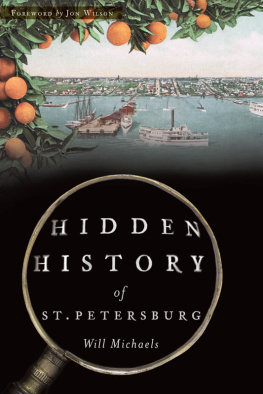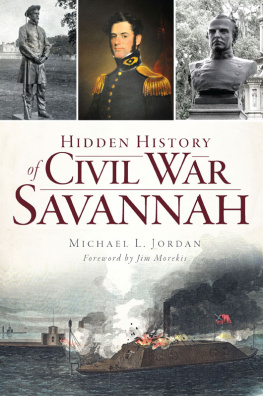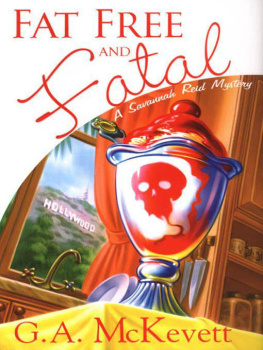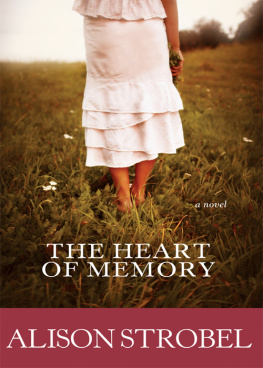


Published by The History Press
Charleston, SC
www.historypress.com
Copyright 2019 by Brenna Michaels and T.C. Michaels
All rights reserved
First published 2019
E-Book edition 2019
ISBN 978.1.43966.609.8
Library of Congress Control Number: 2018960963
Print edition ISBN 978.1.46714.112.3
Notice: The information in this book is true and complete to the best of our knowledge. It is offered without guarantee on the part of the authors or The History Press. The authors and The History Press disclaim all liability in connection with the use of this book.
All rights reserved. No part of this book may be reproduced or transmitted in any form whatsoever without prior written permission from the publisher except in the case of brief quotations embodied in critical articles and reviews.
For Rhett. To know where youve come from.
CONTENTS
PREFACE
Its hard to imagine a place that could get under your skin quite like Savannah. Its more than the picturesque squares, the cobblestones or the moss-draped branches. Theres a nobility that hangs on the air. The past walks hand in hand with the present, leaping to life every time someone pauses to remember.
And theres so much to be remembered. The souls who planted this old place beside the ocean more than two hundred years ago. The brothers and sisters who shot up on this American soil and dreamed new dreams, unleashed by freedom and fresh starts and driven on by bravery and gumption the like the world has rarely seen since.
The names of famous and not-so-famous settlers are still granted to newborn Savannah babies. Its street names echo the birthrights of fallen war heroes and controversial governors alike. The conglomeration of culture and foreign blood brought together in the pursuit of happiness makes up the heartbeat of this vibrant place.
And while to walk Savannahs streets today feels something like stepping into a fairytale, it has been a long road to bring it here. As with all beautiful stories, good intentions have met with tragedy, beauty has sometimes been swallowed up by the beast and the struggle to make it past dark nights into morning has, at times, been nearly too much to bear. And yet time and again, Savannah emerged from each new challenge more stalwart, more beautiful and more treasured than before.
In writing this book, we have made every effort to honor the notable and the not-so-well-remembered histories of our exquisite home of Savannah. Living and working and raising our child in the historic district has been one of the blessings of our life, and we hope to have recounted the lesser-told stories of this place into a work that can be enjoyed by anyone and everyone.
As public historians and professional storytellers within our Savannah-based business, Genteel & Bard, we have done our best to bring forth the most accurate and interesting representations of Savannahs rather storied and sometimes convoluted past. We would like to thank the Georgia Historical Society, the Historic Savannah Foundation and all the many Savannah natives and academic professionals who have had a hand in aiding our research.
What a blessing to dive deeper into familiar waters. Welcome to Savannah, yall. Were so happy to share it with you.
INTRODUCTION
It was a dream that, by all accounts, never should have come true. Time and again, this city of Savannah stood on the edge of ruin, brought to its knees by bloody battles, mysterious pestilence, fire, unforgiving weather and the drums of war.
Once seen as an undesirable hovel, the unlikely Gem of the South became known as the Little London, where society flourished and colonial ladies wore bonnets of silk. The city was built up from the mud around them, and alligators swam the waters just outside town. It was a society built on utopian ideals, a perfect experiment pitting the intentions of honorable men against unspeakable hardships.
And somehow, out of each new challenge, the city rose again stronger, firmer in its identity than before. This place, too beautiful for even the ruthless General Sherman to burn during his March to the Sea, has birthed innovation and culture that changed the course of a nation. Men whose names echo in history once walked its streets. And those who come to visit today are bound to hear tales and legends of the Hostess City that have been told ten thousand times before.
But what of the countless faces seemingly forgotten, the names that history held in looser grip but whose souls left impressions too deep to disappear? Savannahs hidden history is long and wide, as murky as its coastal river and capricious as the tossing waves that kiss its island shores.
SAVANNAHS BEGINNING
THE INSPIRATION FOR A COLONY
Perhaps its best to start at the beginning. To remember how human hearts dreamed up a place where men could be free to dream and live and work, broken from the bonds of class division and hardship.
It was 1729, and England was securely rooted in a culture marred by prejudice, inequality and social unrest. King George II was on the throne, and the Spanish were racing to establish dominance in the New World. Britain had already laid claim to twelve colonies and was working to expand its global footprint.
James Edward Oglethorpe, remembered as the first governor of Georgia, was born in London to a prominent family and enjoyed a comfortable childhood. It would have been easy to stay within rank, to focus on his own affairs and continue to build the wealth and prestige of his family. But James had the heart of an adventurer, and his views on society and culture, justice and the way he believed things should be navigated his decisions, whether thought out or impulsive. After a stint of formal education, a military foray in Austria and a victorious bid for a seat in the House of Parliament, Oglethorpes attention was drawn to the people.
James Oglethorpe was said to have been idealistic and passionate about issues of social justice. But when his good friend Robert Castell fell on hard times and was thrown into one of Londons dreaded debtors prisons, Oglethorpes philosophies were called into action. Englands debtors prisons formed a self-destructive system. Those who could not pay their outstanding debts were held to account by being thrown in prison until they could settle the funds against them. Of course, this was almost impossible to accomplish behind prison walls, and so many who found themselves there never made it out. They were dark, depressing places where otherwise upstanding members of society were treated like criminals and subjected to horrible living conditions. If prisoners could afford to at least pay the prison warden, they could, on occasion, arrange for more tolerable living conditions as they strategized their release. But this was a rare occurrence. Most prisoners died of malnourishment, and more still passed away from diseases like smallpox.

General James Oglethorpe. Courtesy of the New York Public Library.
Such was the case with Oglethorpes friend Castell. His unjust death so troubled Oglethorpe that it sparked an idea, a seed of consolation, if not redemption, for those still suffering. Oglethorpe approached King George II with a proposition: a settlement in the Americas, a new colony, meant to add to Britains wealth and international standing but also to offer an escape to those who otherwise had no hope of working off their debts. Oglethorpe believed that Englands poor deserved a chance to reclaim their lives and better themselves and their futures.
Next page














